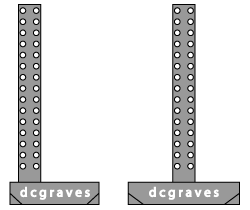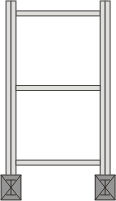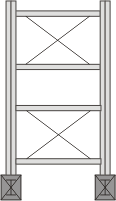|
Cantilever Racking Systems - Three Basic Components
Uprights

Single & Double Sided Uprights
Arms
 
Straight & Inclined Arms
Brace Sets
 
#3B and #4B Brace Sets
Uprights:
The cantilever heavy duty storage racks consist of uprights with a vertical column bolted to a horizontal base. A minimum of two uprights must be ordered to create a cantilever racking unit. The vertical column of the cantilever rack upright is punched on 3" centers, up and down the upright. Also the front and the back of the vertical column is punched, thus the vertical columns can be used as a single sided upright or a double sided upright depending on which type of base is attached to the vertical column. Color Gray.
Never attach an arm to the back side of a single sided upright.
Holes are provided in the base of the upright to anchor the upright to the floor. Never attach the upright to walls, columns or other structures.
Arms:
The cantilever arm is the heart of the cantilever rack system. Arms are adjustable on 3" centers up and down the upright. The arms attach to the upright with a hair pin keeper, the hair pin keeper allows for instant arm adjustability. Arms are available with or without front lips. The arms are available in two types straight arms and incline arms. Color Gray
Straight Arms:
are generally used to store flat stable items such as lumber, steel sheets, cartons, skids, etc. Straight arms up to and including 48" long have a minimum upward pitch of 3/8" per foot to compensate for deflection, 54" and 60" straight arms have a 5/8" minimum upward pitch per foot.
Inclined Arms:
are generally used to store cylindrical objects or loads that tend to roll forward. Incline arms are pitched upward at 20 degrees or approximately 4.36" per foot
Bolt-On Arm Lips:
2" high bolt-on lips can be added to any cantilever rack arm at no extra cost. Lips can be added or removed to any arm as all arms are manufactured to accept the bolt on lip. When you order your arms with bolt on lips you will also receive bolt on lips for the base of the uprights. Please note that the lips are not intended to bear any portion of the load.
Brace Sets:
Braces are constructed from structural channel and are bolted between uprights to provide lateral stability to the cantilever rack system. The selection of the brace length also determines the arm spacing. Brace lengths are measured from center-line of upright to center-line of upright and are sold in sets. Color Gray
How to Design Cantilever Racking Systems
Step #1 - Know Your Product
The first step in designing a cantilever storage rack system is knowing specific characteristics of the product being stored. Knowing these four product characteristics will aid in following calculations A through E
- What is the length of the product being stored?
- What is the depth of the product being stored?
- What is the height of the product being stored?
- What is the weight of the product being stored?
Step A: Determine the Correct Number and Spacing of Arms
The load must be supported by enough arms to prevent load deflection. Deflection may cause damage to the load being stored as well as damage to the arms. To test for potential deflection problems place your load onto two wooden blocks (simulating two cantilever arms). If there is no deflection it is acceptable to use a two arm system as long as there are no capacity problems. If there is deflection use three blocks, keep adding blocks until there is no deflection. Note: It is IMPORTANT to conduct these tests using the arm spacing formula as detailed below
ARM SPACING FORMULA: The load should overhang the end arms evenly and not be more than one-half the distance from upright centerline to upright centerline.
Step B- Determine the Proper Length of Arm
The depth of the load should never exceed the length of the arm.
If you are storing a load 48" deep you must use a 48" long arm, if you are storing a load 24" deep you must use a 24" long arm.
Never use an arm shorter than the depth of your load.
Note: All arm capacities are based on evenly dispersed static loads.
Rated arm capacities may be seriously diminished if proper loading techniques are not followed.
Step C- Determine the Upright Height
When determining the height of the upright it is important to consider the ceiling height, forklift reach, sprinkler system and any other factors, such as local building codes, that might effect the overall height of the upright.
The height of the upright is determined by adding the base height, the total height of the loads to be stored, the total thickness of the arms to be used and a minimum 6" clearance between the top of every load and the arm above
Considering all of the above factors you should be able to determine your height requirement.
Call and ask sales for our cantilever racking for sale dimensions such as base height and arm thickness.
Step D- Determine Arm and Upright Capacity
Arm Capacity
If properly designed and properly loaded each arm supports an equal amount of the load's weight. By determining the number of arms required per load and dividing it into the weight per load, the required arm capacity is determined.
The example to the right shows each load weighs 6,000 lbs. and that each load is supported by three arms. Dividing the number of arms (3) into the the load weight (6,000 lbs.) determines the minimum arm capacity (2,000 lbs.).
Upright Capacity
To determine the capacity of each upright, multiply the number of arms per upright (on double sided uprights make sure you count the arms on both sides) by the capacity required per arm.
The example to the right shows (4) arms per upright and each arm has a 2,000 lbs. capacity. Multiplying the 4 arms x 2,000 lbs. capacity per arm = 8,000 lbs minimum required upright capacity.
Step E- Determine the Brace Length
The brace length is the horizontal distance from center-line to center-line of uprights. Refer to the various brace set lengths as shown in the price lists. Match the brace length as closely as possible to the arm spacing determined in step A.
Cantilever Rack Accessories
Bolt-On Pipe Sockets:
Ideal for situations where the 2" high lips will not suffice, the bolt-on pipe socket allows the user to add a stop (non-load bearing) to the end of their arms at the height they need. Like the bolt-on lips, these field installed pipe sockets can be added or removed as conditions change. The socket has a inside diameter of 1-3/8", the pipe socket does not come with any pipe, it must be purchased separately. The pipe socket is not intended to bear any portion of the load.
Wire Mesh Decking:
Add wire mesh decking to your cantilever rack to create an uninterrupted storage shelf for lighter materials such as cardboard and long cartons. The wire decks straddle the arms and can be added after your cantilever rack has been installed. Perfect for inside use, wire decks also allows for air and water circulation.
Drop-In Deck Supports:
These deck supports allow the user to create a solid shelf using plywood for small objects suck as boxes, cartons, etc...The deck supports are pre-engineered to accept 2 x 4 cross members to support the plywood deck. These items require field installation.
Steel Decks:
As the name infers, steel decks create a strong cantilever shelf for storage of shorter heavy dies and other industrial equipment that will not span the length b/w your arms. Steel decks can create an uninterrupted steel storage shelf for multiple uses. Perfect for creating lumber racks and much more.
Roof Supports:
Turn any cantilever rack system into a covered storage unit. Roof supports can be added to single or double sided cantilever uprights. Please note that adding roof supports can significantly reduce the overall capacity of your system due to snow and wind loads, we will custom design and engineer the supports to comply with local wind and snow conditions.
|